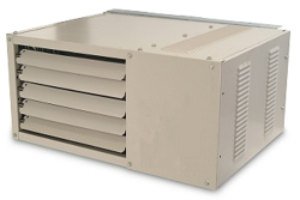|
Propane Garage Heater Types - Pros and Cons of Convection HeatersA propane garage heater is an economical and efficient way to warm your work area on cold winter days. There are several different types of indoor propane heaters available, and choosing the best one for your situation requires that you understand the differences between them. First, there are ventless propane heaters and vented propane heaters. A ventless propane heater releases the exhaust fumes into the garage. It does not require any ductwork, and can be portable. However, the space must be well ventilated for it to be safe. Many portable models are listed "for outdoor use only". If you live at an elevation of 4500 ft. or higher, the safety system on a ventless heater can also cause problems. Because the air is thinner at higher elevations, the oxygen depletion sensor may detect a low oxygen concentration in the air and cause the heater to shut off unnecessarily.
A vented propane heater vents combustion fumes outside through an exhaust duct. This type is generally safer than the ventless design because exhaust fumes and carbon monoxide won't build up inside the building, even if the space is not very well ventilated. The disadvantage is that a vented heater requires a permanent installation and can't be moved around.
Convection Type Propane Heater
Convection heat has a couple advantages over radiant heat. First, the entire garage is warmed evenly and quickly, especially if the heater uses forced air. Second, convection heaters are generally less expensive than radiant heaters with the same BTU output. There are several disadvantages, though. If you open the garage door to move a car in or out, much of the warm air can be lost very quickly through the open door. Plus, the air movement stirs up dust. Also, since warm air rises, you will end up with much of the heat up at the ceiling instead of down near the floor where you are working. Radiant heaters don't have those issues. Since they warm the objects in the garage, you don't lose as much heat through an open door. They don't have blowers stirring up dust, and you don't have as much heat energy ending up wasted at the ceiling. The drawback is that any areas that are shaded from the heater (such as on the opposite side of the big SUV you are working on!) may take a long time to warm up.
Second is the power vented type. It is very similar to the gravity vented unit, but it has a blower that forces the combustion gases out through the exhaust duct. The advantage to using an exhaust blower is that the vent can go through a wall, and you don't have to worry about roof leaks around the vent tube. The safest type of is a separated combustion power vented heater. This type pulls the combustion air from outside the garage, so you don't have to worry about fumes or dust being ignited. It uses two separate vent pipes, one intake and one exhaust. On some models, the intake duct is routed inside of the exhaust duct. This way the intake air is warmed up before going to the combustion chamber, which increases the efficiency.
When trying to choose a propane heater, make sure the one you are looking at is safe for your particular application. Some manufacturers have the owners manuals listed on their website, and it would be a good idea to read the manual for any model you are considering before you buy. This way you may keep yourself from making the expensive or even dangerous mistake of buying a propane garage heater that doesn't suit your needs. To learn about radiant type heaters, see our other page on radiant propane heaters. Want to be able to take your heat with you? Check out our page on portable propane heaters. For more information on other types of heaters, go to our Related Pages menu on the right near the top of this page. Whichever type you decide on, make sure you understand the ventilation or exhaust requirements for the particular model you are buying. I also recommend checking out the owner reviews on Amazon
Return from Propane Garage Heater to Garage Heating
|

Related Pages
on this site:
Garage Heating
Electric
Natural Gas
Propane - Convection
Propane - Radiant
Portable Propane
Ventless Propane
Radiant Tube
Wood Burning
Oil Filled
Waste Oil Furnaces
Waste Oil Heater Plans
Radiant Floor Heating System
Electric Radiant Floor Heat
Hydronic Radiant Floor Heat





